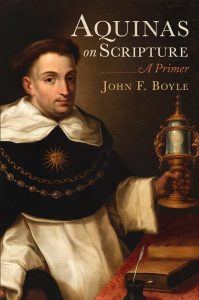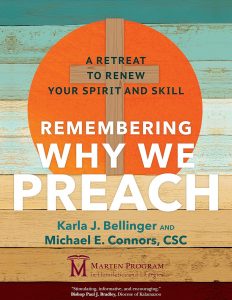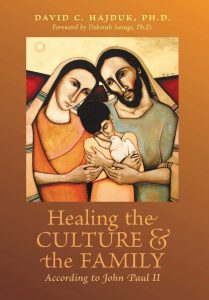Aquinas on Scripture: A Primer. By John F. Boyle. Reviewed by D.M. Walker. (skip to review)
Remembering Why We Preach: A Retreat to Renew Your Spirit and Skill. By Karla J. Bellinger and Michael E. Connors, CSC. Reviewed by Deacon Michael A. Meyer. (skip to review)
Healing the Culture & the Family According to John Paul II. By David C. Hajduk. Reviewed by Fr. Gerald E. Murray. (skip to review)
Honest Rust and Gold: A Second Collection of Prose and Poetry. By Francis Etheredge. Reviewed by Christine Sunderland. (skip to review)
Aquinas on Scripture – John F. Boyle
Boyle, John F. Aquinas on Scripture: A Primer. Steubenville, OH: Emmaus Academic, 2023. 138 pages.
Reviewed by D.M. Walker.
 John F. Boyle’s Aquinas on Scripture: A Primer is simply “an introduction to how St. Thomas Aquinas read and understood Sacred Scripture” (1). Boyle leads the reader through a plethora of scholastic principles, approaches, and purviews of St. Thomas, from Aristotelian and Augustinian influence to Latin technical terms, in order to help the reader to appreciate Thomas’s exegesis of scripture. Boyle, in keeping with his sensible and accessible style, clearly lays out his motive for writing the book: “helping interested readers understand Sacred Scripture as St. Thomas does,” (2) and his intention is executed well. His writing style, clear illustrations, and broad introductions to the many aspects of St. Thomas’ approach to Scripture are a delight to read and helpful for the audience.
John F. Boyle’s Aquinas on Scripture: A Primer is simply “an introduction to how St. Thomas Aquinas read and understood Sacred Scripture” (1). Boyle leads the reader through a plethora of scholastic principles, approaches, and purviews of St. Thomas, from Aristotelian and Augustinian influence to Latin technical terms, in order to help the reader to appreciate Thomas’s exegesis of scripture. Boyle, in keeping with his sensible and accessible style, clearly lays out his motive for writing the book: “helping interested readers understand Sacred Scripture as St. Thomas does,” (2) and his intention is executed well. His writing style, clear illustrations, and broad introductions to the many aspects of St. Thomas’ approach to Scripture are a delight to read and helpful for the audience.
Boyle organizes his book into six chapters. Chapter one, “What Thomas Presumes of His Reader,” covers the basic terminological and conceptual ground needed to plunge further into Thomas; for example, what a word is (5) and what sacred scripture is (8), each with subsections such as the literal sense of scripture (13–24) and the spiritual sense (24–33). The short second chapter is entitled “The Commentator and the Causes” (39–44). It acts as a brief introduction to the role of the commentator and the Aristotelian causes (formal, final, efficient, material) for the uninitiated. Chapters three through six are then broken down according to the four causes.
Boyle, always the Thomist, begins with the end in chapter three, entitled “Why? End or Usefulness (Finis seu utilitas)” (45–59). He deals with Thomas’ understanding of scripture writ large (“it is first and foremost about salvation” 49), and specific books within the whole; for example, the Book of Psalms’ teleological end is “that the soul be joined to God as ‘to him who is holy and exalted’” (52). Boyle also addresses the relationship, and inter-relationship, between the Old Testament and New Testament (54). Several times he addresses what Thomas means by the “intention of the author” (56, 117), as well as the analogia fidei (58).
Chapter four, “Who? Author (Actor seu auctor)” deals with the human and divine authors of Scripture and the relationship between them (61–82). Boyle explains quite simply that “God is the author of Sacred Scripture” (62); he then proceeds to discuss the implications and meaning of such a statement. Aquinas does not ignore the human author, however. Boyle exposits Thomas’s understanding of the human author specifically as an instrumental cause (65) and puts the rubber to the road with several examples (66–74). He ends the chapter with a lengthy discussion of the “holy commentators” who are able to explain Scripture by the same Spirit by which it was produced (76).
Turning to the material cause, chapter five, “What? Matter (materia),” discusses the scholastic manner of getting at the matter of the book (83–110). The includes the classic divisions of the text that are so frequent in Thomas’ commentaries (84–93). Not only can individual books be divided thus, but even the whole of Scripture (94). For example, the Old Testament can be divided according to the teaching of the commandments: the binding commandments and the encouraging commandments (95). Boyle appropriately discusses the frequent phenomenon that can seem quite strange to modern readers — the stark juxtaposition, and seemingly out-of-context citation, of other scriptural texts (a method that illustrates the phenomenon known as intertextuality) (100).
The ultimate chapter, “How? Literary Style (Forma seu Modus)” focuses on the variegated styles in which Scripture is written. The four styles of Scripture include narrative (e.g., Genesis); a cluster composed of preceptive, admonitory, and exhortatory (the Law, prophets, and the books of Solomon, respectively); the disputative style (e.g., Job and Pauline letters); and laudatory (Psalms) (112). He proceeds to analyze them in more depth. Boyle rounds out the chapter with a brief discussion of the question of Christ being found in the literal sense of scripture (133–135).
Perhaps the book’s greatest strength is its sheer accessibility. In true Thomistic fashion, Boyle will revisit topics, treating them from different angles throughout the book — an excellent example of the old adage repititio mater studiorum est. He illustrates principles taken from everyday experience but not by sacrificing learning. There might be quibbles from some about the way some topics are presented or how much of a focus one thing receives in Boyle’s treatment over another, but where two or three are gathered, there quibbling will occur. Legitimate critiques or counter arguments to Thomas are not found in the book, but for an introduction, Boyle’s decision not to include such things might be quite prudent. Unfortunately, there is no bibliography provided for the reader. The focus of the book is not to get overly in depth or preside over an intra-Thomistic interpretation debate. Boyle’s goal was to provide a primer of Thomas on scripture, and to that end, Boyle succeeds. For the MA student already assiduously studying Thomas, this book will be less useful because they will (or should) already know much of its contents. But for those that are trying to broach a seemingly foreign set of texts — St. Thomas’ biblical commentaries — this book will be very helpful.
D. Malachi Walker was born and raised in Nashville, TN. He received his Bachelor of Arts from the Pontifical College Josephinum in Columbus, OH and his Master of Arts from the Hebrew University of Jerusalem in Jerusalem, Israel. He is currently a PhD student at the University of Notre Dame in Notre Dame, Indiana.
Remembering Why We Preach – Karla J. Bellinger and Michael E. Connors, CSC
Bellinger, Karla J., and Michael E. Connors. Remembering Why We Preach: A Retreat to Renew Your Spirit and Skill. Notre Dame, IN: Ave Maria Press, 2022. 128 pages.
Reviewed by Deacon Michael A. Meyer.
 Clergy often greet retreats with one of two emotions: we love them or we hate them. While some find retreats invigorating and spiritually fulfilling, others find them schmaltzy and a waste of time. In Remembering Why We Preach: A Retreat to Renew Your Spirit and Skill, Karla J. Bellinger and Michael E. Connors offer a thought-provoking, spiritually engaging retreat to help seasoned homilists rediscover what called them to the pulpit in the first place — their love of Christ and his people. Remembering Why We Preach is a much-needed, welcome addition to homiletic literature. It is well worth even the busiest preacher’s time.
Clergy often greet retreats with one of two emotions: we love them or we hate them. While some find retreats invigorating and spiritually fulfilling, others find them schmaltzy and a waste of time. In Remembering Why We Preach: A Retreat to Renew Your Spirit and Skill, Karla J. Bellinger and Michael E. Connors offer a thought-provoking, spiritually engaging retreat to help seasoned homilists rediscover what called them to the pulpit in the first place — their love of Christ and his people. Remembering Why We Preach is a much-needed, welcome addition to homiletic literature. It is well worth even the busiest preacher’s time.
Bellinger and Connors, well-known in Catholic homiletics circles as the directors of the esteemed preaching programs at the University of Dallas and Notre Dame, respectively, have identified a gap in homiletic literature that begged to be filled. While the homiletic pantheon is replete with “how to” texts and books addressing preaching in particular contexts, Bellinger and Connors offer a workbook-style retreat to help veteran preachers deepen their spiritual lives and hone their preaching skills. Emphasizing throughout the text that the central task of preaching is facilitating an encounter with God, Bellinger and Connors have organized Remembering Why We Preach around one question: “How can we as preachers be renewed, deepened, and strengthened so that our preaching leads our people toward an encounter with God?” They answer this question in two parts.
Part I attends to the preacher. In the first half of the retreat, Bellinger and Connors direct their preacher audience inward, helping us consider why we preach, our identity as preachers, and the spiritual roots of our preaching. Part I guides preachers toward an encounter with Christ through chapters covering the fundamental purpose of preaching, Jesus Christ and the Paschal Mystery, homily preparation as a spiritual practice, and the pastoral, communal aspect of preaching. This fourth chapter is an essential segue to Part II, which, unsurprisingly, turns the preacher’s attention to the listener. Here, Bellinger and Connors discuss the preacher’s role as a leader in the dialogue between Scripture and people’s lives and stress the importance of congregational feedback in developing the relationship “between pulpit and pew,” all with the aim of improving preaching. The book closes with practical advice on crafting homilies that help listeners move from an encounter with Christ toward a commitment to discipleship and mission.
Remembering Why We Preach is both easy to follow and comprehensive in content. Each chapter adheres to a delightfully consistent, five-part format: a manageable five-to-ten-page introductory text; discussion and reflection questions; spiritual and practical exercises; additional materials (available via QR code and at the RememberingWhyWePreach website); and suggested readings for further study. Where the introductory text, questions, and exercises are easily readable for all levels of interest, the additional materials and readings for further study include both tried-and-true and fresh works that allow interested readers to dig deeper spiritually and intellectually. While Bellinger and Connors come from the Catholic preaching tradition, and the book takes a notably Catholic tack, the selections offer an ample drink from the much deeper Christian homiletic well.
As a retreat, Remembering Why We Preach is eminently doable. The texts are a quick read, and the questions and exercises are provocative and by no means cloying. Bellinger and Connors further facilitate the book’s intended use as a personal or group retreat by including a meeting outline, homily feedback form, personal goal-setting sheet, and peer-group meeting schedule as appendices. In other words, they leave little room for excuses.
Whether used as a text or a retreat, Remembering Why We Preach is refreshing and inspiring. It reminds preachers of the homiletic dos and don’ts we learned in formation and offers novel suggestions to encourage homiletic innovation. Indeed, homily ideas spring up like mushrooms while engaging each chapter’s “Try This!” section, especially when Bellinger and Connors address the preacher’s vocation as a bridge builder between Scripture and human experience.
There is little to dislike about Remembering Why We Preach. One could quibble that tighter editing would help the two authors speak with one voice throughout the text and that the link to the materials on the RememberingWhyWePreach website is broken (the QR Code works). Neither materially detracts from this solid work. Whether you love retreats or hate them, Bellinger’s and Connors’ wealth of homiletic experience shines throughout this book and makes Remembering Why We Preach well worth your time.
Dcn. Michael A. Meyer lives in Clinton Township, NJ with his wife and two daughters. He is an attorney in the healthcare industry and serves at Saint Catherine of Siena Parish in the Diocese of Metuchen. He received Bachelor of Science in Language and Juris Doctor degrees from Georgetown University, a Certificate in Diaconal Ministry and a Master of Arts in Theology from Saint Elizabeth University, and a Doctor of Ministry in Preaching from Aquinas Institute of Theology. His homilies and other writings can be found on his blog, Ramblings from the Ambo, at www.deaconmikemeyer.com.
Healing the Culture & the Family – David C. Hajduk
Hajduk, David C. Healing the Culture & the Family According to John Paul II. Waterloo, Canada: Arouca Press, 2022. 218 pages.
Reviewed by Fr. Gerald E. Murray.
 I had the blessing of studying under the late Msgr. William B. Smith, professor of Moral Theology at St. Joseph Seminary, Dunwoodie, New York. He was an outstanding defender of orthodox Catholic teaching amid the confusion sown by dissenting theologians in the post-Vatican II era. Msgr. Smith identified the roots of the problems posed by those who claimed that Catholic moral doctrine was in need of a thorough overhaul because of supposedly new ways of understanding reality. Smith observed that all problems in theology come down to problems in philosophy.
I had the blessing of studying under the late Msgr. William B. Smith, professor of Moral Theology at St. Joseph Seminary, Dunwoodie, New York. He was an outstanding defender of orthodox Catholic teaching amid the confusion sown by dissenting theologians in the post-Vatican II era. Msgr. Smith identified the roots of the problems posed by those who claimed that Catholic moral doctrine was in need of a thorough overhaul because of supposedly new ways of understanding reality. Smith observed that all problems in theology come down to problems in philosophy.
Philosophical errors of the past never really die; they carry on in different fashions in different ages. The fruits of these errors are seen in the way people decide that they should carry on their lives. The tragic and destructive fruits of erroneous ways of thinking in our own day are seen in the chaos produced by the sexual revolution of the 1960s.
David C. Hajduk has given us a very scholarly and well-argued exposition of the philosophical roots of modern errors about human identity and human sexuality as analyzed in the teaching of St. John Paul II. He examines the Pope’s critique of the New Manichaeism and its relation to the philosophical and theological errors of René Descartes. He demonstrates that the Pope’s phenomenological analysis of these problems is grounded in his appreciation of the metaphysical realism of St. Thomas Aquinas.
The current insanity of the transgender ideology is a fruit of the widespread error that the human person consists of his/her mind, and that the body is a mechanism for expressing whatever the mind decides about the body. Sexual identity is no longer inherent in the body, but is rather the creation of one’s mind: “I am a male only if I think I am a male. If I think I am a female, even though I have a male body, then I am a female.”
Descartes’ separation of the mind from the body, which reduces the body to a substance associated with the mind, but not in any way integral to the human person, results in treating the body as something to be manipulated or redesigned to conform to one’s ideas. Sexual license is the unsurprising result of a system of thought that claims that all that you really are is your mind, the body is unimportant. Msgr. Smith insisted that the body should not be treated like an envelope containing a letter, which is thrown away since all that matters is what is in the letter.
Hajduk shows how John Paul II tied this way of thinking about the body with the errors of the Manichees in the early Church, and with the errors of medieval Manichean heretics such as the Bogomils and the Cathars. The created world of physical bodies was deemed to be evil by these heretics, and thus man must disdain his body, and disdain the sphere of sexuality which brings forth new bodies with each newborn child. The realm of the spiritual alone is good.
In the Catholic understanding of reality, man is a rational animal; he is a body/soul unity. Material creation is good, and man is called to embrace his God-given role of being fruitful and multiplying. Sexuality is rightly ordered when man chooses to fulfill God’s purposes, respecting the divine order discernible in the nature of the male and female bodies.
Hajduk’s book is based on his doctoral thesis. It reflects his careful analytical skills and his ability to summarize complex ideas in a way that is accessible for interested readers. His exposition of the thought of René Descartes is very helpful, as is his careful review of the beliefs of the Bogomils and Cathars. This background sets the stage for his analysis of John Paul II’s critique of contemporary errors about the nature of man and the purpose of sexuality.
I highly recommend this book to all those who would like to better understand the connection between philosophical errors concerning the nature of man and the current plague of false ideas about how we are to understand what man is and how he is to live a morally sound life.
Father Gerald Murray, a priest of the Archdiocese of New York, received his doctorate in Canon Law from the Gregorian University in Rome and is presently the pastor of Holy Family Church in New York City. A frequent commentator on various media outlets, Fr. Murray is well-known as a member of the so-called Papal Posse on EWTN’s The World Over with Raymond Arroyo, and he is the author of Calming the Storm: Navigating the Crises Facing the Catholic Church and Society (Emmaus Road Publishing, 2022) with Diane Montagna.
Honest Rust and Gold – Francis Etheredge
Honest Rust and Gold: A Second Collection of Prose and Poetry. By Francis Etheredge. St. Louis, MO: En Route Books and Media, 2020. 245 pages.
Reviewed by Christine Sunderland.
 Francis Etheredge has gifted us with a second volume of prose and poetry in Honest Rust and Gold, a collection that flows easily between pieces, between chapters, and between sections: “Before,” “Awareness,” “Technological Leaping,” “Grace,” “The Sacraments,” “Writing,” and “After.”
Francis Etheredge has gifted us with a second volume of prose and poetry in Honest Rust and Gold, a collection that flows easily between pieces, between chapters, and between sections: “Before,” “Awareness,” “Technological Leaping,” “Grace,” “The Sacraments,” “Writing,” and “After.”
To be honest, we are rusty creatures, you and I, and we need polishing. We want to shine like gold, and we cannot do this on our own. But if we enter these pages of grace, we will leave awakened and changed, polished by our Creator.
Honest Rust and Gold journeys into the action of God upon us and within us, seeing all of life — of creation itself — as sacramental, the holiness of matter and meaning and the union of the two, for “matter is itself meaningful — if for no other reason than it bears the trace of its Maker” (30). It is in our lackings, our emptiness, our failures in living and being as we are meant to live and be, our rustiness and wretchedness, our sufferings — it is here, in this space, that God meets us. These things, our imperfections and failures, open the door to His action of grace. He is able to enter and reside in our rooms of meaningful matter, recreating us in His own image of Love, for “Love loves begetting/ new beginnings or it is not love;/ . . . and Love would not/ Love in us/ if Love did not first love us.” (105)
But in order for God to recreate us, we must be honest and take stock of our sins and sufferings, honest about where we have gone astray, honest about the rust. We do this sacramentally through Confession (“like the excavation of a well”) (131) and Baptism and Eucharist, allowing our immersion in the love of God. We must also ask for help, for the Creator created “creatures of choice/ instead of being cast/ into an irrevocable mould/ of being unable to invoke/ His limitless help” (32). For we are immersed in our “sufferings, disappointments, failures, griefs and the everyday pressures . . .” (127). We must redirect our immersions into the mercy of God:
“Are we immersed in the mystery of the mercy of God who looks at what we have done with our lives and makes a work of art from it; indeed, are we able or not to glorify God as the Great Recycler – Who takes the rubbish of sin and transforms our life into a blessing greater than the regret of rubbishing it?” (127)
And so we are baptized in sacred waters and words, “dying and rising of Jesus Christ:/ a bath in which bathing is a descent into the cross’ crucifixion of sin.” (italics mine) (128)
There are times when we must be brought into awareness of our emptiness, our insufficiencies. There are times when we need “the sting of the serpent (Numbers 21:4–9) to wake up to the gratuitousness of what we are given.” (69)
Etheredge is doing his part, thankfully, to wake us up to the reality of our own existence, the reality of our fallen nature, the reality of our need for God, the reality of God’s love for us and his desire to enter our hearts and recreate us. But we must see, and we must ask. We must be “beggars before the Lord.”
Honest Rust and Gold richly weaves prose and poetry to give us phrases to ponder: “scrolling down the/ screen is treading time” (82); “God meets us where we are, loves us as we are, and takes us where we cannot go without Him” (italics mine) (97); “difficulties are there to develop us . . . because our weakness is the opportunity God needs to make His strength’s home in us” (101).
And so much more: “Although Christmas seems to be for the children, the reality of life frequently helps me to see that I need a savior.” (113)
Indeed, we need a savior, as so vividly seen in the world today, with death surrounding us. It is a time for renewal, Etheredge urges, for the Good Shepherd is working among us, “supplanting the ugliness of a disfigured humanity with the beauty of beholding through grace the transformation of it.” (143)
Grace is here to be seen and heard, if we have eyes to see and ears to hear. Etheredge wonders if his words will reach readers, if all his efforts are in vain. Writers often think this, especially those of us who may espouse unpopular beliefs. And we often don’t know how many readers are reading our words, or buying our books, or touched in any way by our writings. Christian writers, however, know it isn’t why we are called to write. For if one reader is touched and changed, if one reader opens his or her heart to God, that one reader seeds the future. The seed will root and flower and produce fruit. God will recreate our world with this one seed.
And so, the sufferings of all are offered to the glory of the Creator as “Words Torn from Tears/ wrought and wrung from sufferings/ and pierced, in places,/ admixed with lightning gifts/ of jeweled graces.” (156)
I, for one, have been touched and changed, to be sure, by these golden, jeweled words. I hope and pray that these poems and meditations reach a wide audience and awaken our world to the love and grace of God among us, for “no one is beyond the reach of God.”
“And even if we are tempted to refuse the outstretched hand of the Lord, may His love prevail over the withdrawal of our hand, grasping us firmly on board the boat bound for heaven . . . through the prayers/ still to be prayed./ Amen.” (229)
I’m looking forward to the boat bound for heaven, to reaching for Christ’s outstretched hand, to be touched and healed, to be made whole, to be pulled into the safety of the ark, pulled from the stormy seas.
Christine Sunderland serves as Managing Editor for American Church Union Publishing. She is the author of seven award-winning novels about faith and family, freedom of speech and religion, and the importance of history and human dignity. She lives in the San Francisco Bay Area with her husband and a white longhair cat named Angel.

Recent Comments